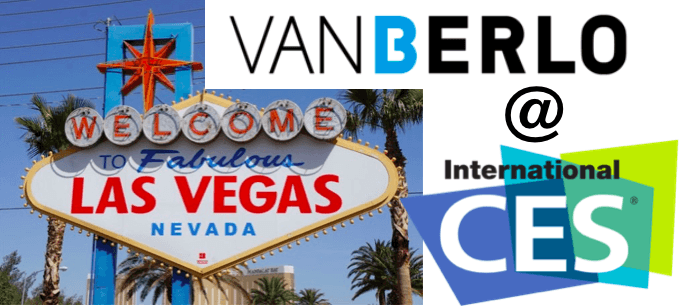
Coen Claassen, Senior Designer at VanBerlo, and Martijn Baller, System Architect at VanBerlo, are visiting the Consumer Electronics Show (CES) in Las Vegas. In a daily diary they share their vision and their experiences at the world’s biggest gathering place of innovative products. Today part 4, by Martijn Baller.
On the third day we tried to see the highlights we missed in the last two days and spend some extra time on both CES locations, Tech West and Tech East. NXP, Texas Instruments, ROHM, Nordic and Microchip, to mention a few, had some nice tech demos to show, Bluetooth 5.0 is a hot topic. Where Bluetooth 4.2 added features especially focused on security, 5.0 allows a mode with larger range or higher bandwidth. Long range means several 100 meters in open air so in home Bluetooth 5.0 could be used for sensors in the whole house directly connected to your phone. The high bandwidth allows for transmission of voice and fast over the air updates. While we also came across products with voice command transmission on the CES this year, we expect that next year even more products will have the ability to be controlled using voice. Which voice recognition algorithm will be used remains a question.
Similar to last year we were surprised by the many robots in all kinds of forms. Some were cute and friendly to educate children, but others had one dedicated function, like barbecue cleaning. Especially Japanese companies are very creative in finding applications for these robots. One of them showed a table lamp that can be controlled using voice commands. It is also equipped with a camera that connects to an app for stop motion movies of your sketches.
Casio had some interesting products this year. A 2,5D printer was shown that prints with heat and ink on special paper. The paper contained a special material that expands when heated up. Making it possible to print and prototype textures on paper that you can really feel. While the printer and paper didn’t come cheap, they explained that it is a promising technology for car interior prototyping, because it can pattern out textures of leather and textiles realistically.
We visited Tanvas, a startup with technology to make touchscreens with haptic feedback. This could be the next step in haptic touchscreen technology. Other companies were focusing more on voice and gesture control. A nice addition to gesture control is to have some sort of haptic feedback as well. We saw more than 5 companies displaying products that use a matrix of small ultrasonic directional speakers to create sound that can be felt but cannot be heard. These technologies show to be a promising technology for haptic feedback for gesture control interfaces.
CES 2017 – Day 3 from VanBerlo on Vimeo.
These days, projection technologies seem to be overshadowed by large displays, but we also encountered other interesting new projection applications. Casio showed a small portable prototype that projects the screen of your tablet or phone. It uses an IR camera to track your finger and hereby renders an interactive projected screen on any surface. At the moment SONY offers a similar device, the Experia projector. A spin-out of SONY took this even one step further by adding the ability to detect objects placed on the project screen. This enables augmented projection and an interesting demonstration brought the book of Alice in Wonderland to life in an interactive way. Our last highlight of the day was a huge 8K tilled led matrix display of 11 x 3 m by Sony.
Tomorrow we will start our long journey back and will write a recap of the CES 2017. So stay tuned!



